Taxation Law of Australia Individual Assignment, Term 2 2019
VerifiedAdded on 2022/09/16
|11
|2937
|17
Homework Assignment
AI Summary
This document presents a comprehensive solution to a taxation law assignment, focusing on various aspects of Australian taxation. The solution addresses several key areas, including the determination of when a business activity is considered to have been carried out, the treatment of gifts and contributions as deductions, and the highest tax rate for individuals. It delves into the Capital Gains Tax (CGT) regime, specifically discussing exemptions for motorcycles and cars, and the treatment of lost or demolished assets. The assignment also explores the assessability of income, differentiating between ordinary income and statutory income, and examines the implications of the Medicare levy and Medicare levy surcharge. Furthermore, the solution analyzes the residence and domicile tests for individuals leaving Australia, and provides examples of deductible and non-deductible expenses. The assignment also covers CGT events related to leased properties and the calculation of CGT for shares and main residences.
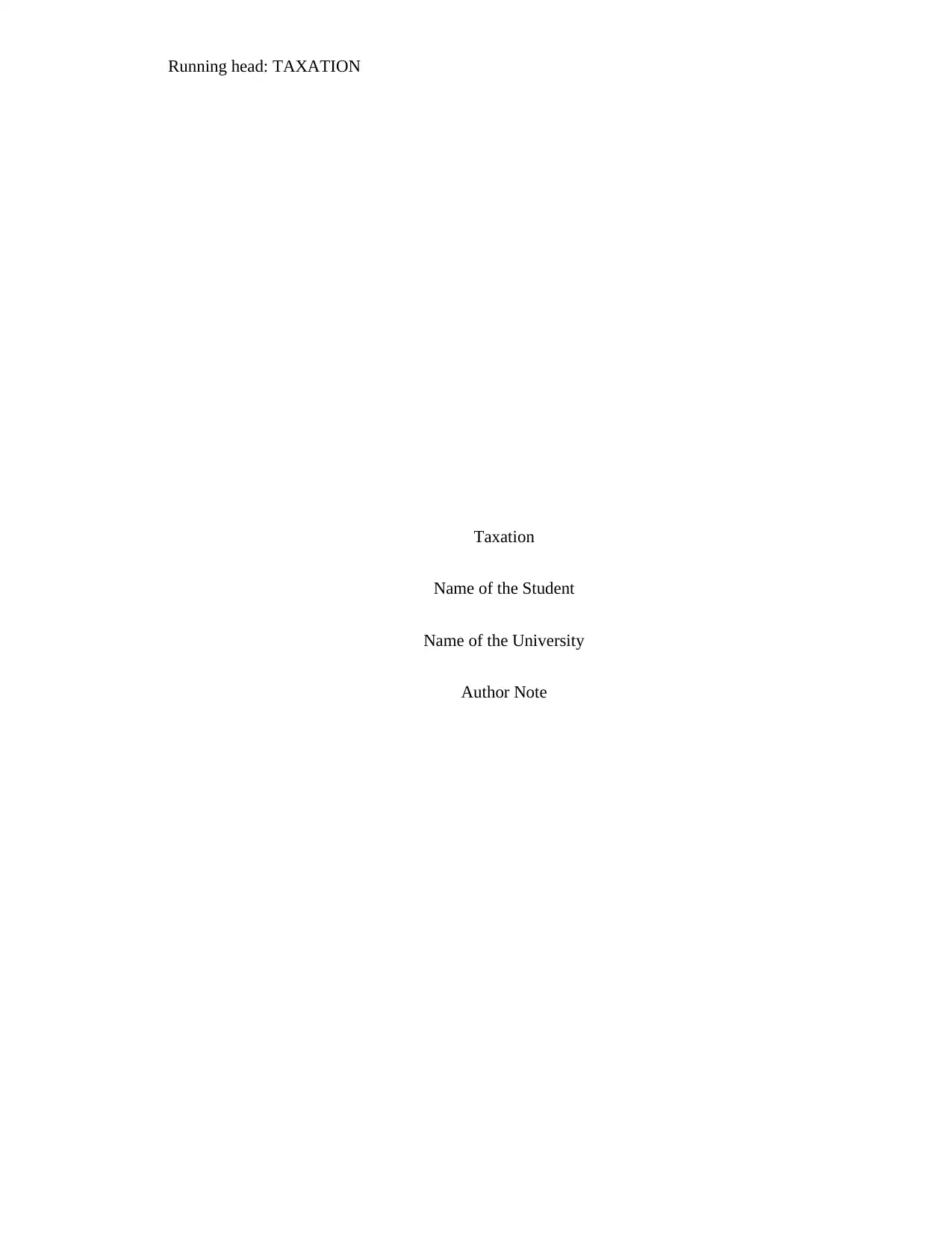
Running head: TAXATION
Taxation
Name of the Student
Name of the University
Author Note
Taxation
Name of the Student
Name of the University
Author Note
Paraphrase This Document
Need a fresh take? Get an instant paraphrase of this document with our AI Paraphraser
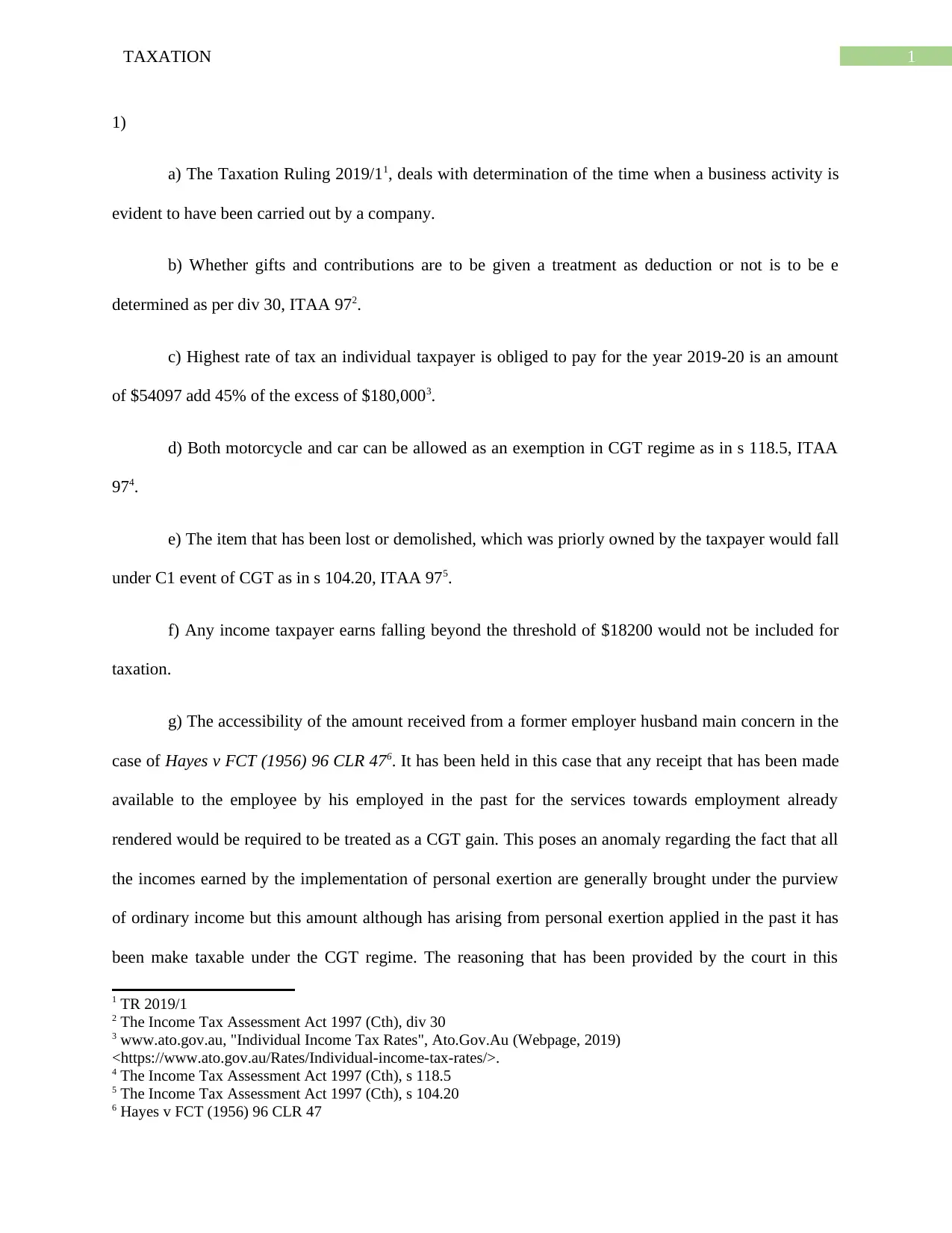
1TAXATION
1)
a) The Taxation Ruling 2019/11, deals with determination of the time when a business activity is
evident to have been carried out by a company.
b) Whether gifts and contributions are to be given a treatment as deduction or not is to be e
determined as per div 30, ITAA 972.
c) Highest rate of tax an individual taxpayer is obliged to pay for the year 2019-20 is an amount
of $54097 add 45% of the excess of $180,0003.
d) Both motorcycle and car can be allowed as an exemption in CGT regime as in s 118.5, ITAA
974.
e) The item that has been lost or demolished, which was priorly owned by the taxpayer would fall
under C1 event of CGT as in s 104.20, ITAA 975.
f) Any income taxpayer earns falling beyond the threshold of $18200 would not be included for
taxation.
g) The accessibility of the amount received from a former employer husband main concern in the
case of Hayes v FCT (1956) 96 CLR 476. It has been held in this case that any receipt that has been made
available to the employee by his employed in the past for the services towards employment already
rendered would be required to be treated as a CGT gain. This poses an anomaly regarding the fact that all
the incomes earned by the implementation of personal exertion are generally brought under the purview
of ordinary income but this amount although has arising from personal exertion applied in the past it has
been make taxable under the CGT regime. The reasoning that has been provided by the court in this
1 TR 2019/1
2 The Income Tax Assessment Act 1997 (Cth), div 30
3 www.ato.gov.au, "Individual Income Tax Rates", Ato.Gov.Au (Webpage, 2019)
<https://www.ato.gov.au/Rates/Individual-income-tax-rates/>.
4 The Income Tax Assessment Act 1997 (Cth), s 118.5
5 The Income Tax Assessment Act 1997 (Cth), s 104.20
6 Hayes v FCT (1956) 96 CLR 47
1)
a) The Taxation Ruling 2019/11, deals with determination of the time when a business activity is
evident to have been carried out by a company.
b) Whether gifts and contributions are to be given a treatment as deduction or not is to be e
determined as per div 30, ITAA 972.
c) Highest rate of tax an individual taxpayer is obliged to pay for the year 2019-20 is an amount
of $54097 add 45% of the excess of $180,0003.
d) Both motorcycle and car can be allowed as an exemption in CGT regime as in s 118.5, ITAA
974.
e) The item that has been lost or demolished, which was priorly owned by the taxpayer would fall
under C1 event of CGT as in s 104.20, ITAA 975.
f) Any income taxpayer earns falling beyond the threshold of $18200 would not be included for
taxation.
g) The accessibility of the amount received from a former employer husband main concern in the
case of Hayes v FCT (1956) 96 CLR 476. It has been held in this case that any receipt that has been made
available to the employee by his employed in the past for the services towards employment already
rendered would be required to be treated as a CGT gain. This poses an anomaly regarding the fact that all
the incomes earned by the implementation of personal exertion are generally brought under the purview
of ordinary income but this amount although has arising from personal exertion applied in the past it has
been make taxable under the CGT regime. The reasoning that has been provided by the court in this
1 TR 2019/1
2 The Income Tax Assessment Act 1997 (Cth), div 30
3 www.ato.gov.au, "Individual Income Tax Rates", Ato.Gov.Au (Webpage, 2019)
<https://www.ato.gov.au/Rates/Individual-income-tax-rates/>.
4 The Income Tax Assessment Act 1997 (Cth), s 118.5
5 The Income Tax Assessment Act 1997 (Cth), s 104.20
6 Hayes v FCT (1956) 96 CLR 47
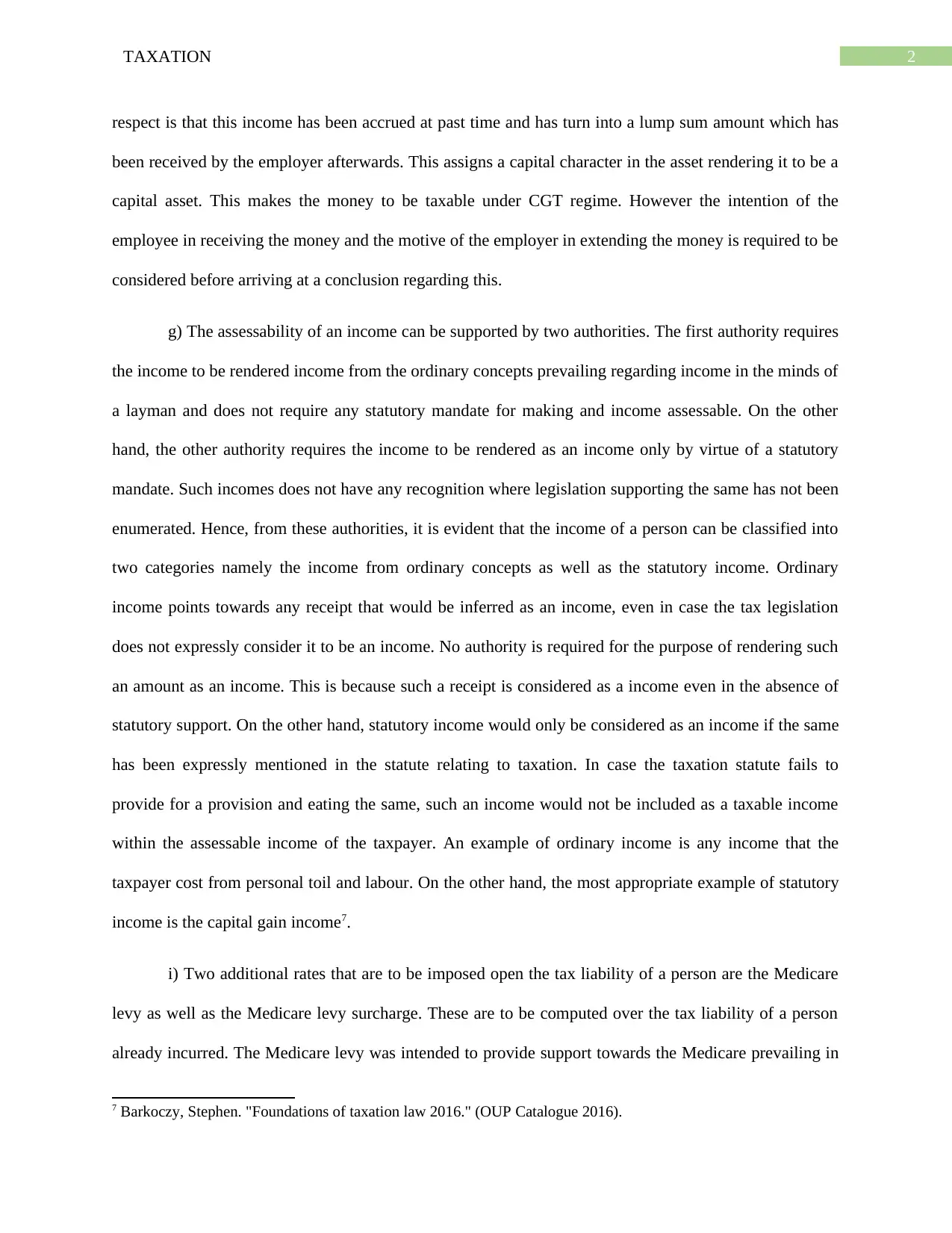
2TAXATION
respect is that this income has been accrued at past time and has turn into a lump sum amount which has
been received by the employer afterwards. This assigns a capital character in the asset rendering it to be a
capital asset. This makes the money to be taxable under CGT regime. However the intention of the
employee in receiving the money and the motive of the employer in extending the money is required to be
considered before arriving at a conclusion regarding this.
g) The assessability of an income can be supported by two authorities. The first authority requires
the income to be rendered income from the ordinary concepts prevailing regarding income in the minds of
a layman and does not require any statutory mandate for making and income assessable. On the other
hand, the other authority requires the income to be rendered as an income only by virtue of a statutory
mandate. Such incomes does not have any recognition where legislation supporting the same has not been
enumerated. Hence, from these authorities, it is evident that the income of a person can be classified into
two categories namely the income from ordinary concepts as well as the statutory income. Ordinary
income points towards any receipt that would be inferred as an income, even in case the tax legislation
does not expressly consider it to be an income. No authority is required for the purpose of rendering such
an amount as an income. This is because such a receipt is considered as a income even in the absence of
statutory support. On the other hand, statutory income would only be considered as an income if the same
has been expressly mentioned in the statute relating to taxation. In case the taxation statute fails to
provide for a provision and eating the same, such an income would not be included as a taxable income
within the assessable income of the taxpayer. An example of ordinary income is any income that the
taxpayer cost from personal toil and labour. On the other hand, the most appropriate example of statutory
income is the capital gain income7.
i) Two additional rates that are to be imposed open the tax liability of a person are the Medicare
levy as well as the Medicare levy surcharge. These are to be computed over the tax liability of a person
already incurred. The Medicare levy was intended to provide support towards the Medicare prevailing in
7 Barkoczy, Stephen. "Foundations of taxation law 2016." (OUP Catalogue 2016).
respect is that this income has been accrued at past time and has turn into a lump sum amount which has
been received by the employer afterwards. This assigns a capital character in the asset rendering it to be a
capital asset. This makes the money to be taxable under CGT regime. However the intention of the
employee in receiving the money and the motive of the employer in extending the money is required to be
considered before arriving at a conclusion regarding this.
g) The assessability of an income can be supported by two authorities. The first authority requires
the income to be rendered income from the ordinary concepts prevailing regarding income in the minds of
a layman and does not require any statutory mandate for making and income assessable. On the other
hand, the other authority requires the income to be rendered as an income only by virtue of a statutory
mandate. Such incomes does not have any recognition where legislation supporting the same has not been
enumerated. Hence, from these authorities, it is evident that the income of a person can be classified into
two categories namely the income from ordinary concepts as well as the statutory income. Ordinary
income points towards any receipt that would be inferred as an income, even in case the tax legislation
does not expressly consider it to be an income. No authority is required for the purpose of rendering such
an amount as an income. This is because such a receipt is considered as a income even in the absence of
statutory support. On the other hand, statutory income would only be considered as an income if the same
has been expressly mentioned in the statute relating to taxation. In case the taxation statute fails to
provide for a provision and eating the same, such an income would not be included as a taxable income
within the assessable income of the taxpayer. An example of ordinary income is any income that the
taxpayer cost from personal toil and labour. On the other hand, the most appropriate example of statutory
income is the capital gain income7.
i) Two additional rates that are to be imposed open the tax liability of a person are the Medicare
levy as well as the Medicare levy surcharge. These are to be computed over the tax liability of a person
already incurred. The Medicare levy was intended to provide support towards the Medicare prevailing in
7 Barkoczy, Stephen. "Foundations of taxation law 2016." (OUP Catalogue 2016).
⊘ This is a preview!⊘
Do you want full access?
Subscribe today to unlock all pages.

Trusted by 1+ million students worldwide
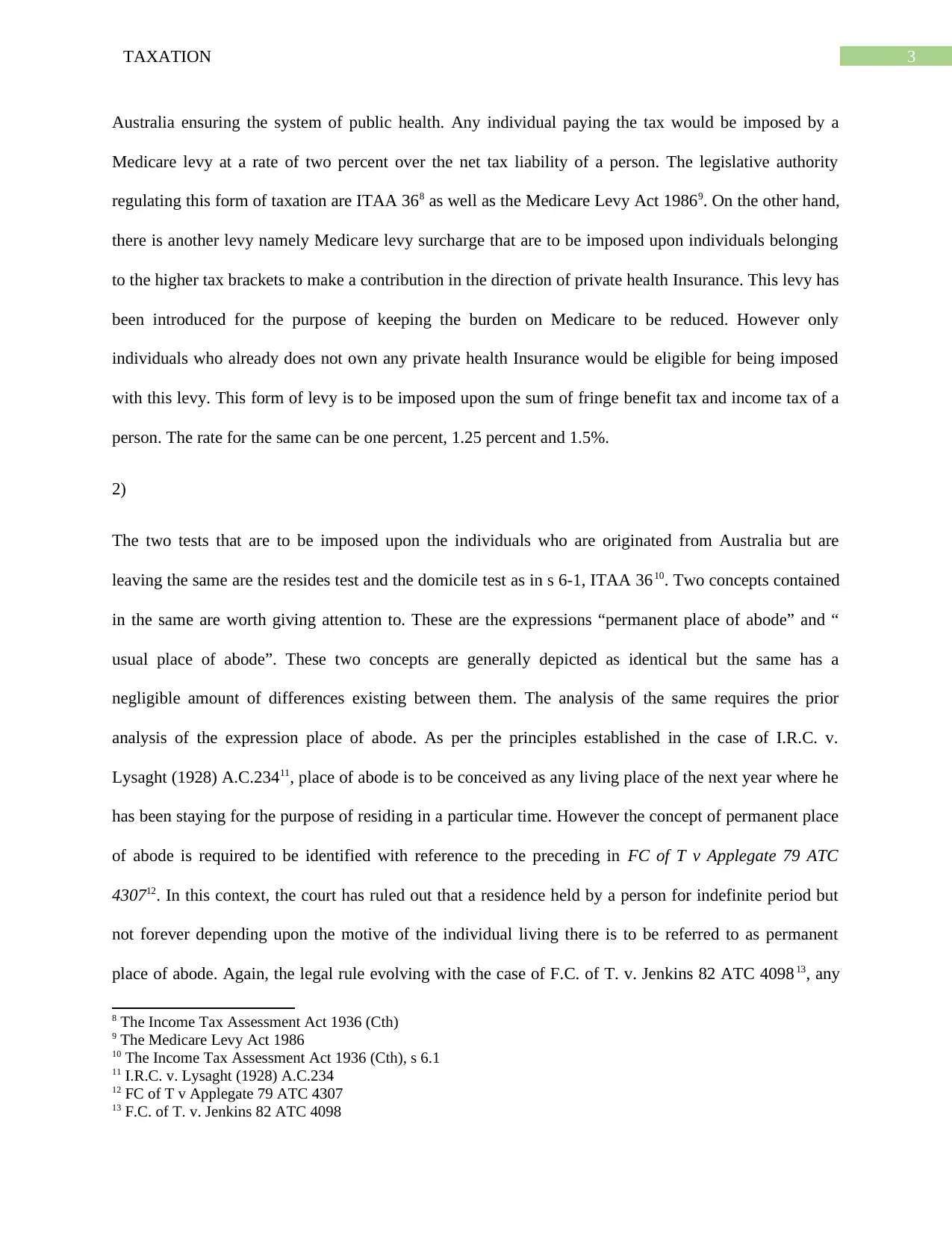
3TAXATION
Australia ensuring the system of public health. Any individual paying the tax would be imposed by a
Medicare levy at a rate of two percent over the net tax liability of a person. The legislative authority
regulating this form of taxation are ITAA 368 as well as the Medicare Levy Act 19869. On the other hand,
there is another levy namely Medicare levy surcharge that are to be imposed upon individuals belonging
to the higher tax brackets to make a contribution in the direction of private health Insurance. This levy has
been introduced for the purpose of keeping the burden on Medicare to be reduced. However only
individuals who already does not own any private health Insurance would be eligible for being imposed
with this levy. This form of levy is to be imposed upon the sum of fringe benefit tax and income tax of a
person. The rate for the same can be one percent, 1.25 percent and 1.5%.
2)
The two tests that are to be imposed upon the individuals who are originated from Australia but are
leaving the same are the resides test and the domicile test as in s 6-1, ITAA 3610. Two concepts contained
in the same are worth giving attention to. These are the expressions “permanent place of abode” and “
usual place of abode”. These two concepts are generally depicted as identical but the same has a
negligible amount of differences existing between them. The analysis of the same requires the prior
analysis of the expression place of abode. As per the principles established in the case of I.R.C. v.
Lysaght (1928) A.C.23411, place of abode is to be conceived as any living place of the next year where he
has been staying for the purpose of residing in a particular time. However the concept of permanent place
of abode is required to be identified with reference to the preceding in FC of T v Applegate 79 ATC
430712. In this context, the court has ruled out that a residence held by a person for indefinite period but
not forever depending upon the motive of the individual living there is to be referred to as permanent
place of abode. Again, the legal rule evolving with the case of F.C. of T. v. Jenkins 82 ATC 4098 13, any
8 The Income Tax Assessment Act 1936 (Cth)
9 The Medicare Levy Act 1986
10 The Income Tax Assessment Act 1936 (Cth), s 6.1
11 I.R.C. v. Lysaght (1928) A.C.234
12 FC of T v Applegate 79 ATC 4307
13 F.C. of T. v. Jenkins 82 ATC 4098
Australia ensuring the system of public health. Any individual paying the tax would be imposed by a
Medicare levy at a rate of two percent over the net tax liability of a person. The legislative authority
regulating this form of taxation are ITAA 368 as well as the Medicare Levy Act 19869. On the other hand,
there is another levy namely Medicare levy surcharge that are to be imposed upon individuals belonging
to the higher tax brackets to make a contribution in the direction of private health Insurance. This levy has
been introduced for the purpose of keeping the burden on Medicare to be reduced. However only
individuals who already does not own any private health Insurance would be eligible for being imposed
with this levy. This form of levy is to be imposed upon the sum of fringe benefit tax and income tax of a
person. The rate for the same can be one percent, 1.25 percent and 1.5%.
2)
The two tests that are to be imposed upon the individuals who are originated from Australia but are
leaving the same are the resides test and the domicile test as in s 6-1, ITAA 3610. Two concepts contained
in the same are worth giving attention to. These are the expressions “permanent place of abode” and “
usual place of abode”. These two concepts are generally depicted as identical but the same has a
negligible amount of differences existing between them. The analysis of the same requires the prior
analysis of the expression place of abode. As per the principles established in the case of I.R.C. v.
Lysaght (1928) A.C.23411, place of abode is to be conceived as any living place of the next year where he
has been staying for the purpose of residing in a particular time. However the concept of permanent place
of abode is required to be identified with reference to the preceding in FC of T v Applegate 79 ATC
430712. In this context, the court has ruled out that a residence held by a person for indefinite period but
not forever depending upon the motive of the individual living there is to be referred to as permanent
place of abode. Again, the legal rule evolving with the case of F.C. of T. v. Jenkins 82 ATC 4098 13, any
8 The Income Tax Assessment Act 1936 (Cth)
9 The Medicare Levy Act 1986
10 The Income Tax Assessment Act 1936 (Cth), s 6.1
11 I.R.C. v. Lysaght (1928) A.C.234
12 FC of T v Applegate 79 ATC 4307
13 F.C. of T. v. Jenkins 82 ATC 4098
Paraphrase This Document
Need a fresh take? Get an instant paraphrase of this document with our AI Paraphraser
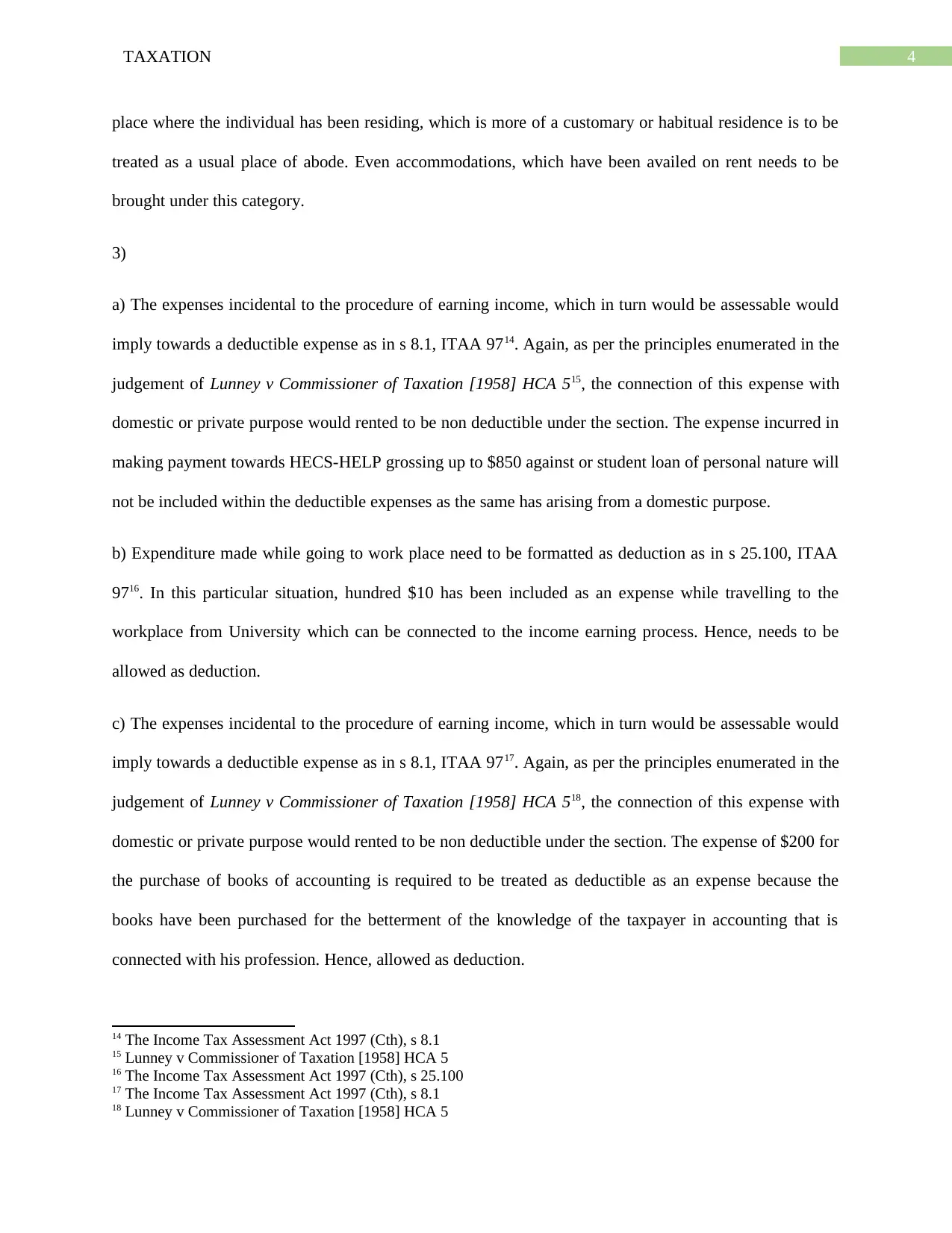
4TAXATION
place where the individual has been residing, which is more of a customary or habitual residence is to be
treated as a usual place of abode. Even accommodations, which have been availed on rent needs to be
brought under this category.
3)
a) The expenses incidental to the procedure of earning income, which in turn would be assessable would
imply towards a deductible expense as in s 8.1, ITAA 9714. Again, as per the principles enumerated in the
judgement of Lunney v Commissioner of Taxation [1958] HCA 515, the connection of this expense with
domestic or private purpose would rented to be non deductible under the section. The expense incurred in
making payment towards HECS-HELP grossing up to $850 against or student loan of personal nature will
not be included within the deductible expenses as the same has arising from a domestic purpose.
b) Expenditure made while going to work place need to be formatted as deduction as in s 25.100, ITAA
9716. In this particular situation, hundred $10 has been included as an expense while travelling to the
workplace from University which can be connected to the income earning process. Hence, needs to be
allowed as deduction.
c) The expenses incidental to the procedure of earning income, which in turn would be assessable would
imply towards a deductible expense as in s 8.1, ITAA 9717. Again, as per the principles enumerated in the
judgement of Lunney v Commissioner of Taxation [1958] HCA 518, the connection of this expense with
domestic or private purpose would rented to be non deductible under the section. The expense of $200 for
the purchase of books of accounting is required to be treated as deductible as an expense because the
books have been purchased for the betterment of the knowledge of the taxpayer in accounting that is
connected with his profession. Hence, allowed as deduction.
14 The Income Tax Assessment Act 1997 (Cth), s 8.1
15 Lunney v Commissioner of Taxation [1958] HCA 5
16 The Income Tax Assessment Act 1997 (Cth), s 25.100
17 The Income Tax Assessment Act 1997 (Cth), s 8.1
18 Lunney v Commissioner of Taxation [1958] HCA 5
place where the individual has been residing, which is more of a customary or habitual residence is to be
treated as a usual place of abode. Even accommodations, which have been availed on rent needs to be
brought under this category.
3)
a) The expenses incidental to the procedure of earning income, which in turn would be assessable would
imply towards a deductible expense as in s 8.1, ITAA 9714. Again, as per the principles enumerated in the
judgement of Lunney v Commissioner of Taxation [1958] HCA 515, the connection of this expense with
domestic or private purpose would rented to be non deductible under the section. The expense incurred in
making payment towards HECS-HELP grossing up to $850 against or student loan of personal nature will
not be included within the deductible expenses as the same has arising from a domestic purpose.
b) Expenditure made while going to work place need to be formatted as deduction as in s 25.100, ITAA
9716. In this particular situation, hundred $10 has been included as an expense while travelling to the
workplace from University which can be connected to the income earning process. Hence, needs to be
allowed as deduction.
c) The expenses incidental to the procedure of earning income, which in turn would be assessable would
imply towards a deductible expense as in s 8.1, ITAA 9717. Again, as per the principles enumerated in the
judgement of Lunney v Commissioner of Taxation [1958] HCA 518, the connection of this expense with
domestic or private purpose would rented to be non deductible under the section. The expense of $200 for
the purchase of books of accounting is required to be treated as deductible as an expense because the
books have been purchased for the betterment of the knowledge of the taxpayer in accounting that is
connected with his profession. Hence, allowed as deduction.
14 The Income Tax Assessment Act 1997 (Cth), s 8.1
15 Lunney v Commissioner of Taxation [1958] HCA 5
16 The Income Tax Assessment Act 1997 (Cth), s 25.100
17 The Income Tax Assessment Act 1997 (Cth), s 8.1
18 Lunney v Commissioner of Taxation [1958] HCA 5
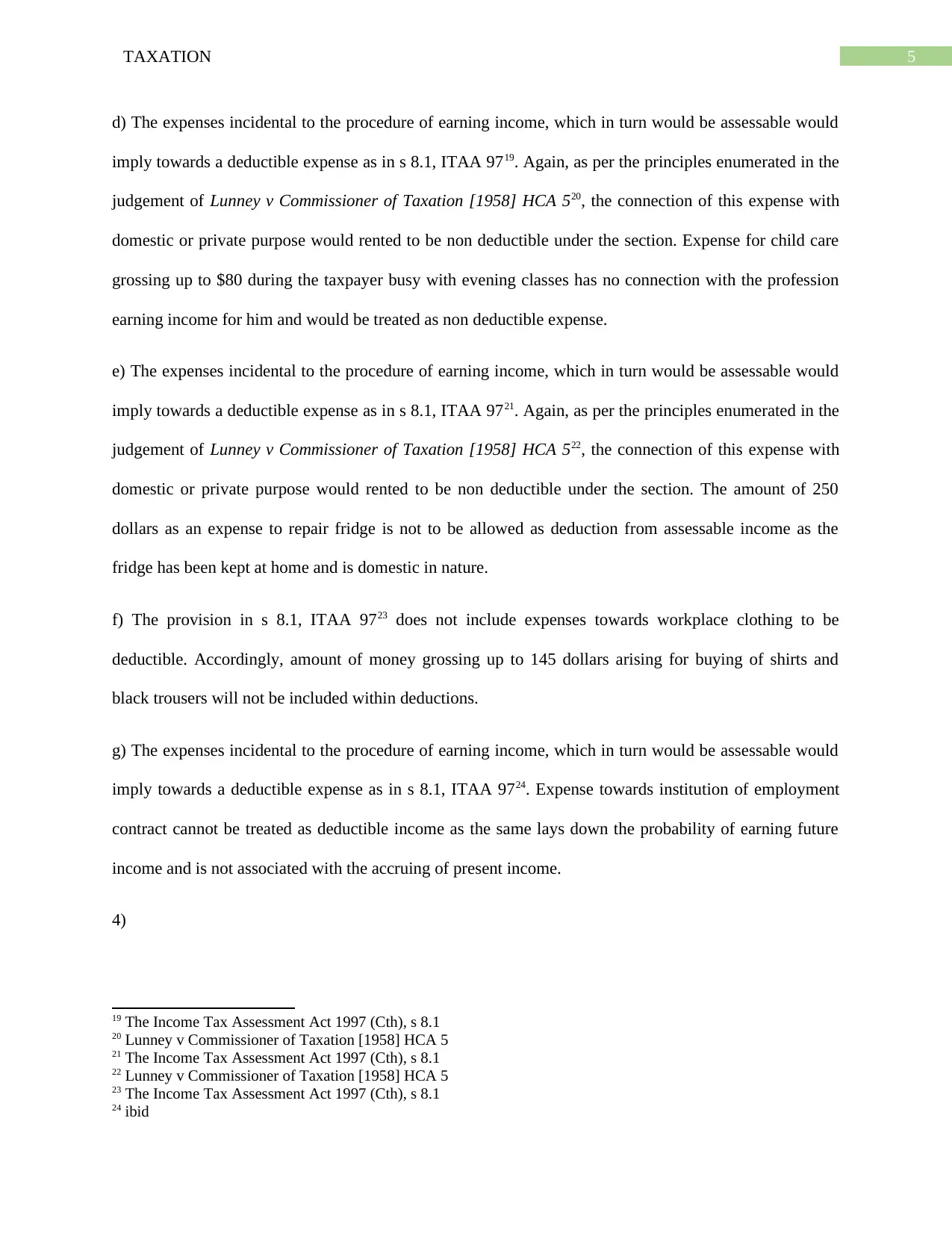
5TAXATION
d) The expenses incidental to the procedure of earning income, which in turn would be assessable would
imply towards a deductible expense as in s 8.1, ITAA 9719. Again, as per the principles enumerated in the
judgement of Lunney v Commissioner of Taxation [1958] HCA 520, the connection of this expense with
domestic or private purpose would rented to be non deductible under the section. Expense for child care
grossing up to $80 during the taxpayer busy with evening classes has no connection with the profession
earning income for him and would be treated as non deductible expense.
e) The expenses incidental to the procedure of earning income, which in turn would be assessable would
imply towards a deductible expense as in s 8.1, ITAA 9721. Again, as per the principles enumerated in the
judgement of Lunney v Commissioner of Taxation [1958] HCA 522, the connection of this expense with
domestic or private purpose would rented to be non deductible under the section. The amount of 250
dollars as an expense to repair fridge is not to be allowed as deduction from assessable income as the
fridge has been kept at home and is domestic in nature.
f) The provision in s 8.1, ITAA 9723 does not include expenses towards workplace clothing to be
deductible. Accordingly, amount of money grossing up to 145 dollars arising for buying of shirts and
black trousers will not be included within deductions.
g) The expenses incidental to the procedure of earning income, which in turn would be assessable would
imply towards a deductible expense as in s 8.1, ITAA 9724. Expense towards institution of employment
contract cannot be treated as deductible income as the same lays down the probability of earning future
income and is not associated with the accruing of present income.
4)
19 The Income Tax Assessment Act 1997 (Cth), s 8.1
20 Lunney v Commissioner of Taxation [1958] HCA 5
21 The Income Tax Assessment Act 1997 (Cth), s 8.1
22 Lunney v Commissioner of Taxation [1958] HCA 5
23 The Income Tax Assessment Act 1997 (Cth), s 8.1
24 ibid
d) The expenses incidental to the procedure of earning income, which in turn would be assessable would
imply towards a deductible expense as in s 8.1, ITAA 9719. Again, as per the principles enumerated in the
judgement of Lunney v Commissioner of Taxation [1958] HCA 520, the connection of this expense with
domestic or private purpose would rented to be non deductible under the section. Expense for child care
grossing up to $80 during the taxpayer busy with evening classes has no connection with the profession
earning income for him and would be treated as non deductible expense.
e) The expenses incidental to the procedure of earning income, which in turn would be assessable would
imply towards a deductible expense as in s 8.1, ITAA 9721. Again, as per the principles enumerated in the
judgement of Lunney v Commissioner of Taxation [1958] HCA 522, the connection of this expense with
domestic or private purpose would rented to be non deductible under the section. The amount of 250
dollars as an expense to repair fridge is not to be allowed as deduction from assessable income as the
fridge has been kept at home and is domestic in nature.
f) The provision in s 8.1, ITAA 9723 does not include expenses towards workplace clothing to be
deductible. Accordingly, amount of money grossing up to 145 dollars arising for buying of shirts and
black trousers will not be included within deductions.
g) The expenses incidental to the procedure of earning income, which in turn would be assessable would
imply towards a deductible expense as in s 8.1, ITAA 9724. Expense towards institution of employment
contract cannot be treated as deductible income as the same lays down the probability of earning future
income and is not associated with the accruing of present income.
4)
19 The Income Tax Assessment Act 1997 (Cth), s 8.1
20 Lunney v Commissioner of Taxation [1958] HCA 5
21 The Income Tax Assessment Act 1997 (Cth), s 8.1
22 Lunney v Commissioner of Taxation [1958] HCA 5
23 The Income Tax Assessment Act 1997 (Cth), s 8.1
24 ibid
⊘ This is a preview!⊘
Do you want full access?
Subscribe today to unlock all pages.

Trusted by 1+ million students worldwide
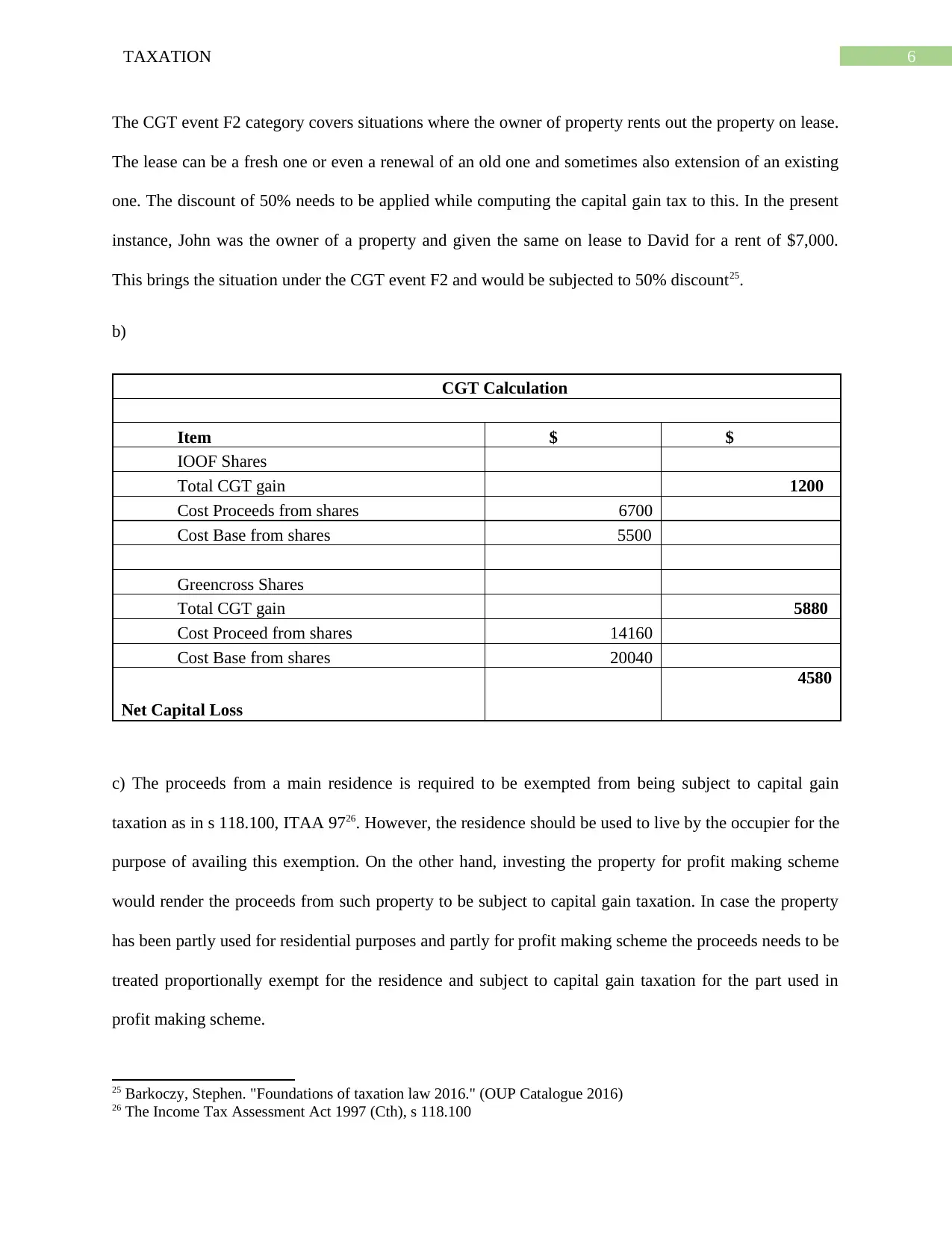
6TAXATION
The CGT event F2 category covers situations where the owner of property rents out the property on lease.
The lease can be a fresh one or even a renewal of an old one and sometimes also extension of an existing
one. The discount of 50% needs to be applied while computing the capital gain tax to this. In the present
instance, John was the owner of a property and given the same on lease to David for a rent of $7,000.
This brings the situation under the CGT event F2 and would be subjected to 50% discount25.
b)
CGT Calculation
Item $ $
IOOF Shares
Total CGT gain 1200
Cost Proceeds from shares 6700
Cost Base from shares 5500
Greencross Shares
Total CGT gain 5880
Cost Proceed from shares 14160
Cost Base from shares 20040
Net Capital Loss
4580
c) The proceeds from a main residence is required to be exempted from being subject to capital gain
taxation as in s 118.100, ITAA 9726. However, the residence should be used to live by the occupier for the
purpose of availing this exemption. On the other hand, investing the property for profit making scheme
would render the proceeds from such property to be subject to capital gain taxation. In case the property
has been partly used for residential purposes and partly for profit making scheme the proceeds needs to be
treated proportionally exempt for the residence and subject to capital gain taxation for the part used in
profit making scheme.
25 Barkoczy, Stephen. "Foundations of taxation law 2016." (OUP Catalogue 2016)
26 The Income Tax Assessment Act 1997 (Cth), s 118.100
The CGT event F2 category covers situations where the owner of property rents out the property on lease.
The lease can be a fresh one or even a renewal of an old one and sometimes also extension of an existing
one. The discount of 50% needs to be applied while computing the capital gain tax to this. In the present
instance, John was the owner of a property and given the same on lease to David for a rent of $7,000.
This brings the situation under the CGT event F2 and would be subjected to 50% discount25.
b)
CGT Calculation
Item $ $
IOOF Shares
Total CGT gain 1200
Cost Proceeds from shares 6700
Cost Base from shares 5500
Greencross Shares
Total CGT gain 5880
Cost Proceed from shares 14160
Cost Base from shares 20040
Net Capital Loss
4580
c) The proceeds from a main residence is required to be exempted from being subject to capital gain
taxation as in s 118.100, ITAA 9726. However, the residence should be used to live by the occupier for the
purpose of availing this exemption. On the other hand, investing the property for profit making scheme
would render the proceeds from such property to be subject to capital gain taxation. In case the property
has been partly used for residential purposes and partly for profit making scheme the proceeds needs to be
treated proportionally exempt for the residence and subject to capital gain taxation for the part used in
profit making scheme.
25 Barkoczy, Stephen. "Foundations of taxation law 2016." (OUP Catalogue 2016)
26 The Income Tax Assessment Act 1997 (Cth), s 118.100
Paraphrase This Document
Need a fresh take? Get an instant paraphrase of this document with our AI Paraphraser
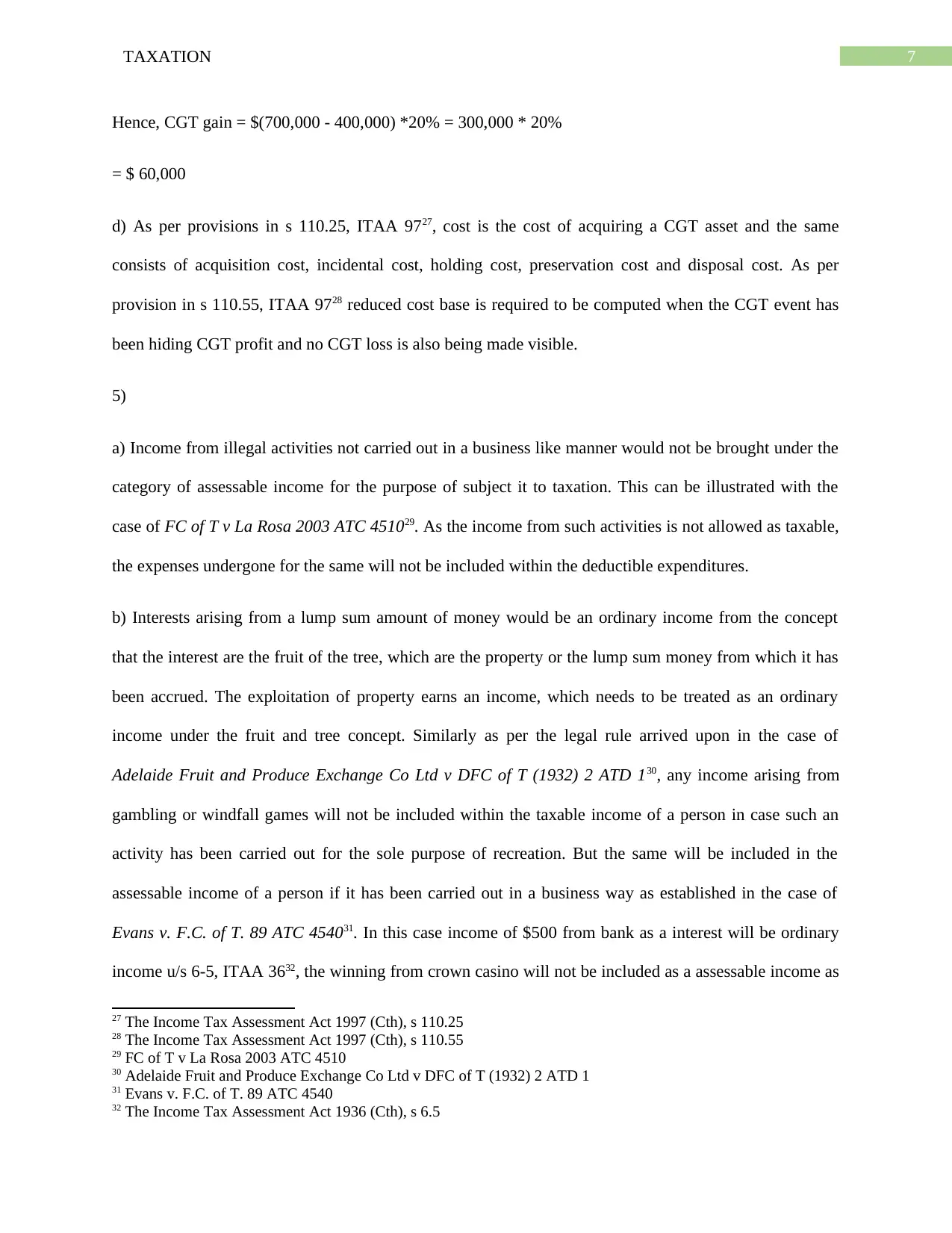
7TAXATION
Hence, CGT gain = $(700,000 - 400,000) *20% = 300,000 * 20%
= $ 60,000
d) As per provisions in s 110.25, ITAA 9727, cost is the cost of acquiring a CGT asset and the same
consists of acquisition cost, incidental cost, holding cost, preservation cost and disposal cost. As per
provision in s 110.55, ITAA 9728 reduced cost base is required to be computed when the CGT event has
been hiding CGT profit and no CGT loss is also being made visible.
5)
a) Income from illegal activities not carried out in a business like manner would not be brought under the
category of assessable income for the purpose of subject it to taxation. This can be illustrated with the
case of FC of T v La Rosa 2003 ATC 451029. As the income from such activities is not allowed as taxable,
the expenses undergone for the same will not be included within the deductible expenditures.
b) Interests arising from a lump sum amount of money would be an ordinary income from the concept
that the interest are the fruit of the tree, which are the property or the lump sum money from which it has
been accrued. The exploitation of property earns an income, which needs to be treated as an ordinary
income under the fruit and tree concept. Similarly as per the legal rule arrived upon in the case of
Adelaide Fruit and Produce Exchange Co Ltd v DFC of T (1932) 2 ATD 130, any income arising from
gambling or windfall games will not be included within the taxable income of a person in case such an
activity has been carried out for the sole purpose of recreation. But the same will be included in the
assessable income of a person if it has been carried out in a business way as established in the case of
Evans v. F.C. of T. 89 ATC 454031. In this case income of $500 from bank as a interest will be ordinary
income u/s 6-5, ITAA 3632, the winning from crown casino will not be included as a assessable income as
27 The Income Tax Assessment Act 1997 (Cth), s 110.25
28 The Income Tax Assessment Act 1997 (Cth), s 110.55
29 FC of T v La Rosa 2003 ATC 4510
30 Adelaide Fruit and Produce Exchange Co Ltd v DFC of T (1932) 2 ATD 1
31 Evans v. F.C. of T. 89 ATC 4540
32 The Income Tax Assessment Act 1936 (Cth), s 6.5
Hence, CGT gain = $(700,000 - 400,000) *20% = 300,000 * 20%
= $ 60,000
d) As per provisions in s 110.25, ITAA 9727, cost is the cost of acquiring a CGT asset and the same
consists of acquisition cost, incidental cost, holding cost, preservation cost and disposal cost. As per
provision in s 110.55, ITAA 9728 reduced cost base is required to be computed when the CGT event has
been hiding CGT profit and no CGT loss is also being made visible.
5)
a) Income from illegal activities not carried out in a business like manner would not be brought under the
category of assessable income for the purpose of subject it to taxation. This can be illustrated with the
case of FC of T v La Rosa 2003 ATC 451029. As the income from such activities is not allowed as taxable,
the expenses undergone for the same will not be included within the deductible expenditures.
b) Interests arising from a lump sum amount of money would be an ordinary income from the concept
that the interest are the fruit of the tree, which are the property or the lump sum money from which it has
been accrued. The exploitation of property earns an income, which needs to be treated as an ordinary
income under the fruit and tree concept. Similarly as per the legal rule arrived upon in the case of
Adelaide Fruit and Produce Exchange Co Ltd v DFC of T (1932) 2 ATD 130, any income arising from
gambling or windfall games will not be included within the taxable income of a person in case such an
activity has been carried out for the sole purpose of recreation. But the same will be included in the
assessable income of a person if it has been carried out in a business way as established in the case of
Evans v. F.C. of T. 89 ATC 454031. In this case income of $500 from bank as a interest will be ordinary
income u/s 6-5, ITAA 3632, the winning from crown casino will not be included as a assessable income as
27 The Income Tax Assessment Act 1997 (Cth), s 110.25
28 The Income Tax Assessment Act 1997 (Cth), s 110.55
29 FC of T v La Rosa 2003 ATC 4510
30 Adelaide Fruit and Produce Exchange Co Ltd v DFC of T (1932) 2 ATD 1
31 Evans v. F.C. of T. 89 ATC 4540
32 The Income Tax Assessment Act 1936 (Cth), s 6.5
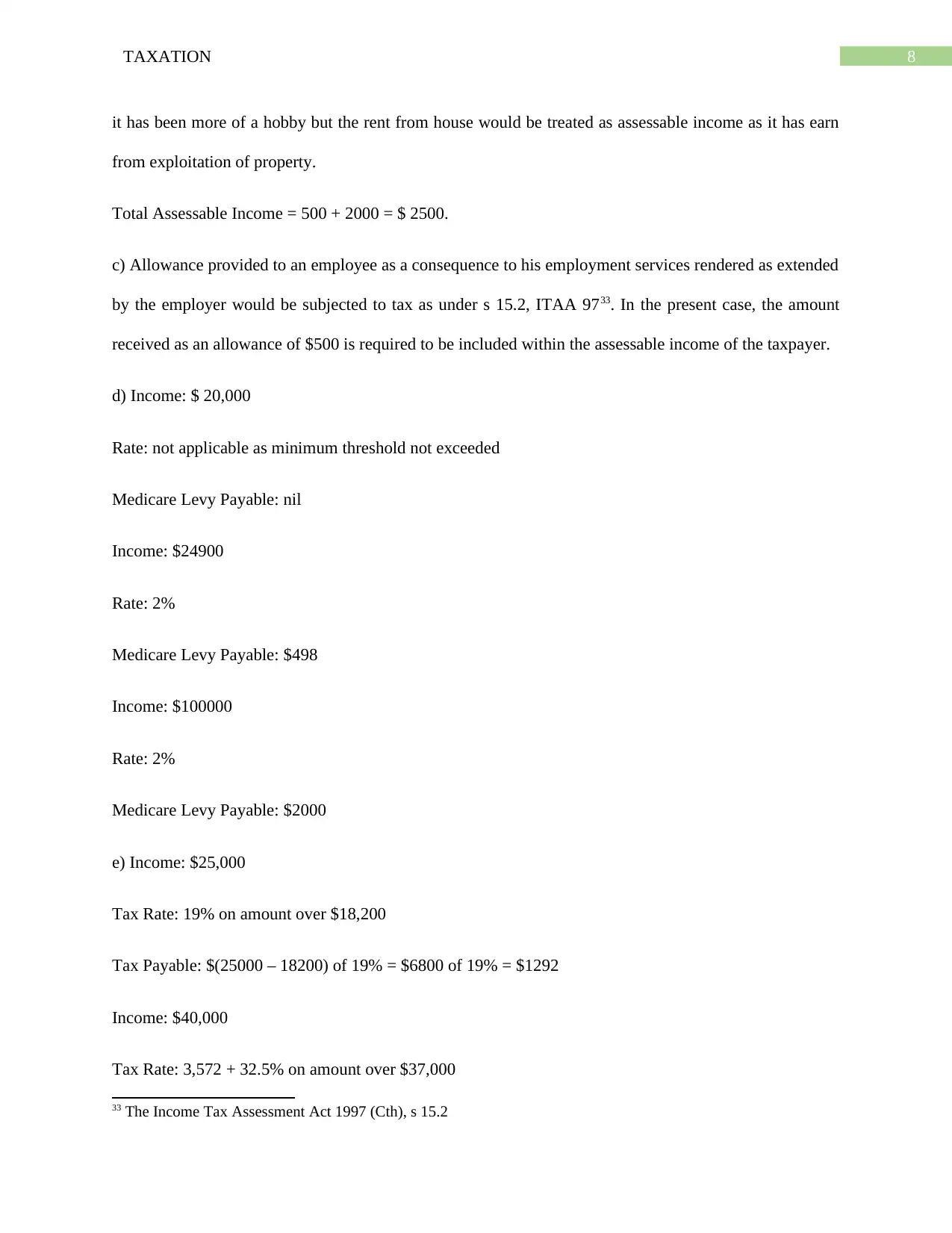
8TAXATION
it has been more of a hobby but the rent from house would be treated as assessable income as it has earn
from exploitation of property.
Total Assessable Income = 500 + 2000 = $ 2500.
c) Allowance provided to an employee as a consequence to his employment services rendered as extended
by the employer would be subjected to tax as under s 15.2, ITAA 9733. In the present case, the amount
received as an allowance of $500 is required to be included within the assessable income of the taxpayer.
d) Income: $ 20,000
Rate: not applicable as minimum threshold not exceeded
Medicare Levy Payable: nil
Income: $24900
Rate: 2%
Medicare Levy Payable: $498
Income: $100000
Rate: 2%
Medicare Levy Payable: $2000
e) Income: $25,000
Tax Rate: 19% on amount over $18,200
Tax Payable: $(25000 – 18200) of 19% = $6800 of 19% = $1292
Income: $40,000
Tax Rate: 3,572 + 32.5% on amount over $37,000
33 The Income Tax Assessment Act 1997 (Cth), s 15.2
it has been more of a hobby but the rent from house would be treated as assessable income as it has earn
from exploitation of property.
Total Assessable Income = 500 + 2000 = $ 2500.
c) Allowance provided to an employee as a consequence to his employment services rendered as extended
by the employer would be subjected to tax as under s 15.2, ITAA 9733. In the present case, the amount
received as an allowance of $500 is required to be included within the assessable income of the taxpayer.
d) Income: $ 20,000
Rate: not applicable as minimum threshold not exceeded
Medicare Levy Payable: nil
Income: $24900
Rate: 2%
Medicare Levy Payable: $498
Income: $100000
Rate: 2%
Medicare Levy Payable: $2000
e) Income: $25,000
Tax Rate: 19% on amount over $18,200
Tax Payable: $(25000 – 18200) of 19% = $6800 of 19% = $1292
Income: $40,000
Tax Rate: 3,572 + 32.5% on amount over $37,000
33 The Income Tax Assessment Act 1997 (Cth), s 15.2
⊘ This is a preview!⊘
Do you want full access?
Subscribe today to unlock all pages.

Trusted by 1+ million students worldwide
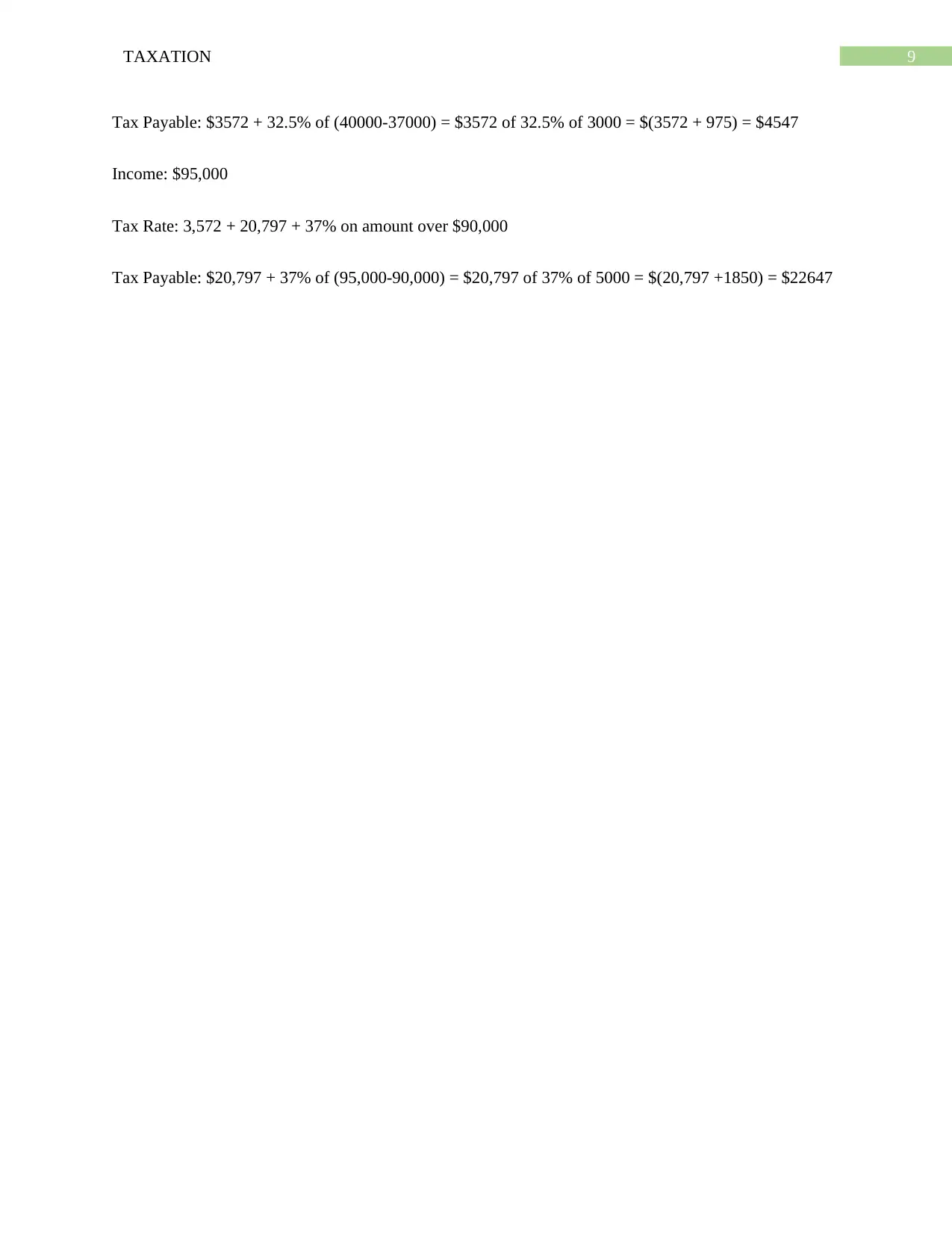
9TAXATION
Tax Payable: $3572 + 32.5% of (40000-37000) = $3572 of 32.5% of 3000 = $(3572 + 975) = $4547
Income: $95,000
Tax Rate: 3,572 + 20,797 + 37% on amount over $90,000
Tax Payable: $20,797 + 37% of (95,000-90,000) = $20,797 of 37% of 5000 = $(20,797 +1850) = $22647
Tax Payable: $3572 + 32.5% of (40000-37000) = $3572 of 32.5% of 3000 = $(3572 + 975) = $4547
Income: $95,000
Tax Rate: 3,572 + 20,797 + 37% on amount over $90,000
Tax Payable: $20,797 + 37% of (95,000-90,000) = $20,797 of 37% of 5000 = $(20,797 +1850) = $22647
Paraphrase This Document
Need a fresh take? Get an instant paraphrase of this document with our AI Paraphraser
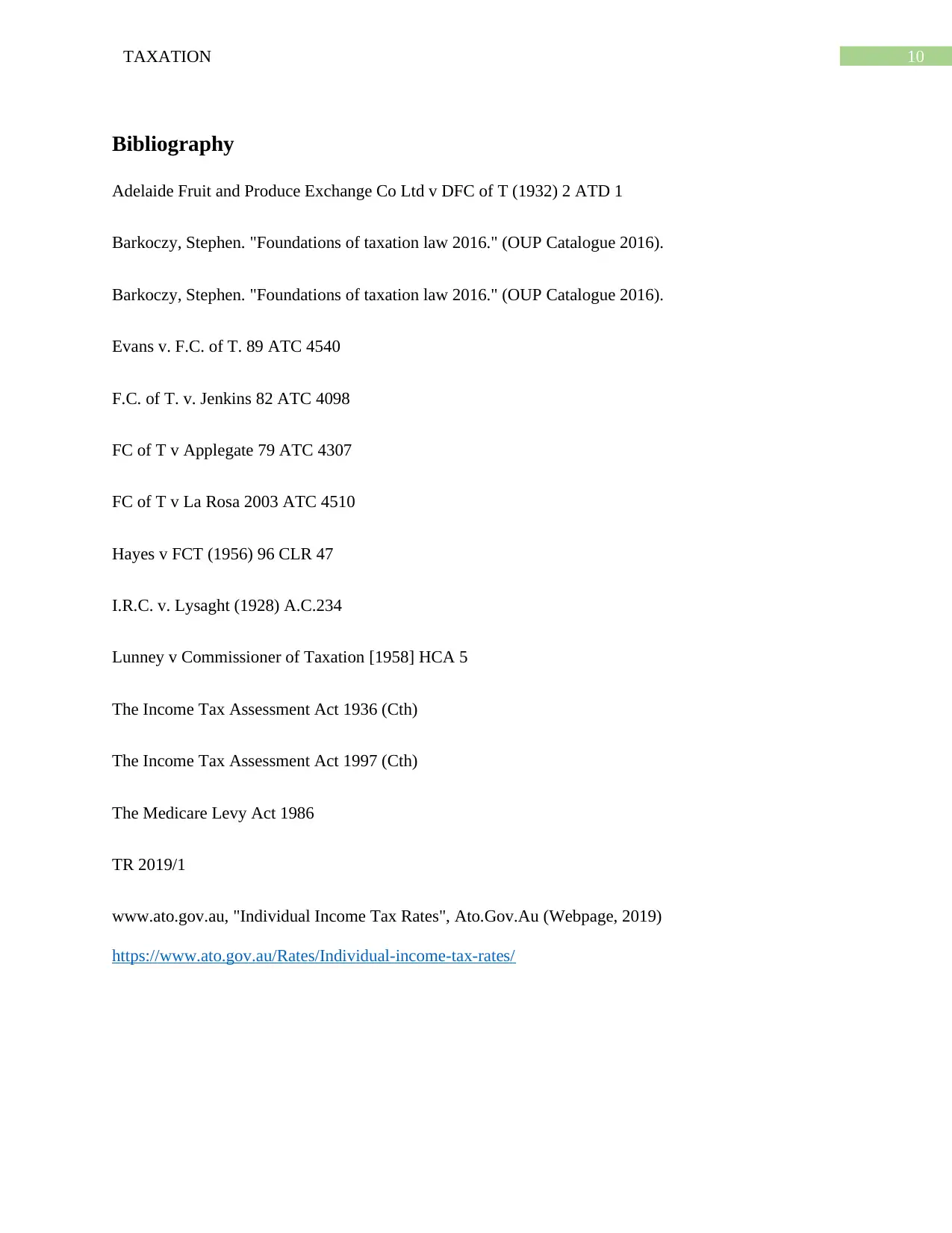
10TAXATION
Bibliography
Adelaide Fruit and Produce Exchange Co Ltd v DFC of T (1932) 2 ATD 1
Barkoczy, Stephen. "Foundations of taxation law 2016." (OUP Catalogue 2016).
Barkoczy, Stephen. "Foundations of taxation law 2016." (OUP Catalogue 2016).
Evans v. F.C. of T. 89 ATC 4540
F.C. of T. v. Jenkins 82 ATC 4098
FC of T v Applegate 79 ATC 4307
FC of T v La Rosa 2003 ATC 4510
Hayes v FCT (1956) 96 CLR 47
I.R.C. v. Lysaght (1928) A.C.234
Lunney v Commissioner of Taxation [1958] HCA 5
The Income Tax Assessment Act 1936 (Cth)
The Income Tax Assessment Act 1997 (Cth)
The Medicare Levy Act 1986
TR 2019/1
www.ato.gov.au, "Individual Income Tax Rates", Ato.Gov.Au (Webpage, 2019)
https://www.ato.gov.au/Rates/Individual-income-tax-rates/
Bibliography
Adelaide Fruit and Produce Exchange Co Ltd v DFC of T (1932) 2 ATD 1
Barkoczy, Stephen. "Foundations of taxation law 2016." (OUP Catalogue 2016).
Barkoczy, Stephen. "Foundations of taxation law 2016." (OUP Catalogue 2016).
Evans v. F.C. of T. 89 ATC 4540
F.C. of T. v. Jenkins 82 ATC 4098
FC of T v Applegate 79 ATC 4307
FC of T v La Rosa 2003 ATC 4510
Hayes v FCT (1956) 96 CLR 47
I.R.C. v. Lysaght (1928) A.C.234
Lunney v Commissioner of Taxation [1958] HCA 5
The Income Tax Assessment Act 1936 (Cth)
The Income Tax Assessment Act 1997 (Cth)
The Medicare Levy Act 1986
TR 2019/1
www.ato.gov.au, "Individual Income Tax Rates", Ato.Gov.Au (Webpage, 2019)
https://www.ato.gov.au/Rates/Individual-income-tax-rates/
1 out of 11
Related Documents
Your All-in-One AI-Powered Toolkit for Academic Success.
+13062052269
info@desklib.com
Available 24*7 on WhatsApp / Email
![[object Object]](/_next/static/media/star-bottom.7253800d.svg)
Unlock your academic potential
Copyright © 2020–2025 A2Z Services. All Rights Reserved. Developed and managed by ZUCOL.





